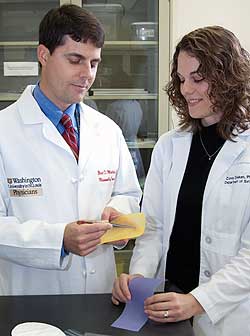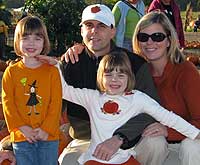It seems like a contradiction: scar-free surgery. But for Brent Matthews, M.D., scar-free surgery is nearing reality.

Matthews, chief of the Department of Surgery’s Section of Minimally Invasive Surgery, is on the leading edge of innovations to make minimally invasive surgery even, well, less invasive.
He removes patients’ gallbladders with a technique that requires just a single, small incision in the belly button. The procedure leaves only a barely visible scar. He’s also laying the groundwork for abdominal surgeries performed through natural openings in the body — the mouth or vagina — rather than cuts in the belly.
For patients, this new twist on surgery is expected to mean even less pain and faster recoveries.
“One of the big challenges of minimally invasive surgery is developing new ways to do surgeries that are already done very well,” Matthews says. “The bar is much higher today. But we think there’s still room for improvement by reducing patients’ pain, their recovery times and even the amount of scarring.”
Matthews, associate professor of surgery, is an exceptional surgeon, widely known for his expertise in minimally invasive abdominal surgeries. He’s also the kind of doctor that medical students and residents aspire to be.
Colleagues and young proteges say Matthews is generous with his time and has the patience of a saint.
“By nature, he’s calm and cool,” says Timothy Eberlein, M.D., the Bixby Professor and chairman of the Department of Surgery, the Spencer T. and Ann W. Olin Distinguished Professor and director of the Siteman Cancer Center. “Brent accomplishes so much, a lot of it behind the scenes. He brings out the best in everyone he works with. He’s a fantastic mentor — medical students and residents love him.”
In his own days as a medical student, Matthews witnessed a revolution in surgery take shape. He stood alongside surgeons removing a patient’s gallbladder, but not with the customary 10-inch incision extending from the rib cage to the belly button. The surgeons made several half-inch incisions in the patient’s abdomen through which they passed miniaturized instruments and a high-resolution video camera. Their movements were guided by video images displayed on monitors in the operating room.
“It was overwhelming and exciting,” Matthews says. “I felt like there were no limits to what could be developed. This was the future of surgery, and I wanted to be a part of it.”
Since then, laparoscopy has replaced traditional, open surgeries for removing the gallbladder and appendix and repairing hernias. And it has become increasingly common for bariatric procedures to treat morbid obesity and for gynecologic and urologic surgeries. The smaller incisions have significantly reduced patients’ pain and their recuperation time.
Now, surgeons like Matthews are pushing the envelope even further by moving toward “scarless” procedures. But he says, “It’s not simply a matter of deciding that something is cool and offering it to patients. Part of the process of introducing new procedures is to determine when the technology is appropriate and for which patients.”
True academic surgeon
Matthews was recruited to the School of Medicine in 2004 from the Carolinas Medical Center in Charlotte, N.C., where he was on the faculty at the University of North Carolina School of Medicine. Eberlein, who was looking for a surgeon with expertise in minimally invasive surgery, called three colleagues in the field.

“They all said to call Brent Matthews,” Eberlein says. “One said, ‘If you can get him, you’ve recruited the best guy in the country.’ Dr. Matthews has lived up to that.”
Matthews was lured by Eberlein’s vision of minimally invasive surgery as a true subspecialty of surgery.
“This was unique because most academic institutions still consider minimally invasive surgery a part of general surgery, not a subspecialty in itself,” Matthews says. “It was also clear that Washington University as an institution was very supportive of innovations in minimally invasive surgery, even though single-incision and natural-orifice procedures were just concepts at the time.”
Since 2007, when Matthews was named chief of minimally invasive surgery, he has established an ambitious program to research and develop new minimally invasive procedures, including robotic techniques, and to train faculty, residents and students.
“Brent Matthews is a real superstar,” says William Chapman, M.D., chief of the Section of Transplant Surgery in the Department of Surgery. “He has established himself as an outstanding member of the surgery department in every imaginable way. He provides outstanding patient care and is one of the most sought-after surgeons in the Division of General Surgery, both among patients and referring physicians. He’s also known by students, residents and fellows for his excellence in teaching.”
Matthews says he relishes his career as academic surgeon.
“Academic medicine really stimulates you to think, to stay current, to explore innovative ideas to move the field forward,” he says. “And there’s the continuing challenge from residents and students — you don’t get that in a private practice.”
Before Matthews and other minimally invasive surgeons bring new techniques into the operating room, they practice on simulators in a laboratory setting.
He envisions that most laparoscopic abdominal surgeries now performed through four or five small incisions soon will be accomplished through one incision at the belly button or by combining the single-incision approach with robotic surgery, where a surgeon sits at a computer console maneuvering joystick-like controls that guide scalpels, scissors and high-resolution cameras through small incisions.
This dual approach would allow surgeons to work in multiple areas of the abdomen without the crowding of instruments through one incision.
Matthews expects that natural orifice procedures will be reserved, at least initially, for surgeries to remove the gallbladder or the appendix. Both procedures are still in the experimental stage and will first be evaluated at the medical school through clinical trials, expected to get under way in the next 18 months. While there are no external cuts regardless of how the surgeon enters the body, there still is cutting through internal tissues to reach and operate on organs.
|
Brent Matthews |
|
Born: March 25, 1961, in Chicago Education: B.A., chemistry, Miami University (Ohio); M.D., Indiana University School of Medicine Family: Wife, Nicole; daughters Riley, 6, and Lauren, 4 Hobbies: Golf and running Passionate about: Surgical mission trips. He has made three trips to Haiti and one to the Dominican Republic, in which he led a team of 11 from the School of Medicine. He is planning a return trip in January. |
“These procedures are either less invasive ways to care for patients or enable us to use technologies like robotics to do more complex surgeries using minimally invasive techniques,” Matthews says.
To incorporate these new procedures into clinical practice, Matthews has hired two new faculty members, both with expertise in single-incision surgery and robotics. Michael Awad, M.D., Ph.D., hails from Johns Hopkins Hospital, where he also gained experience in natural orifice surgery. Esteban Varela, M.D., who arrives in January, comes from the University of Texas Southwestern.
Caring for others
Matthews’ generosity and talent extend well beyond the medical school. He has made three surgical mission trips to Haiti, and, in January, he led a team of 11 from the School of Medicine to the Dominican Republic.
“There is an incredible need in developing countries,” he says. “We are so lucky here in the United States, and these people, who have little access to medical care, have so much hope.”
Matthews organized the trip with Peggy Frisella, manager of the minimally invasive surgery lab, who is a nurse by training. The team included residents, anesthetists, a fellow in minimally invasive surgery and support staff. They performed 61 hernia repairs and other abdominal surgeries in five days, working from early morning to late in the evening. The group went with the expectation that all the patients would be adults, but Matthews says they couldn’t turn away eight children, all in need of hernia surgery.
The mission trip was made possible through grants from the Barnes-Jewish Hospital Foundation and Christian World Relief. Matthews even paid for part of the group’s expenses out of his own pocket.
“It was a great experience,” says Matthews, who is planning a return trip in January. “There’s a lot of personal reward you get by helping others. And it is only magnified in a close group like ours.”
For Matthews, the experience provided yet another teaching opportunity for the next generation of surgeons, not just in surgical techniques but also in compassion and caring.
It was not an experience lost on surgery resident Lora Melman, M.D., who works in Matthews’ lab and was part of the mission team.
“It was an amazing experience,” she says. “Dr. Matthews leads by example. He’s confident and relaxed and just the kind of surgeon that all residents aspire to be: dedicated, caring and very professional. He has a way of putting you at ease so you can do your very best.”